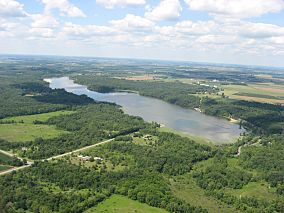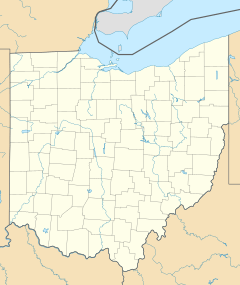Kiser Lake Wetlands State Nature Preserve facts for kids
Quick facts for kids Kiser Lake Wetlands State Nature Preserve |
|
|---|---|
| Kiser Lake Wetlands | |

Kiser Lake viewed from the south,
wetlands are in bottom right of image |
|
| Location | Champaign County, Ohio |
| Nearest city | St. Paris |
| Area | 51 acres (21 ha) |
| Established | 1940 |
| Governing body | Ohio Department of Natural Resources |
| Kiser Lake Wetlands Website | |
The Kiser Lake Wetlands State Nature Preserve is a special natural area in Ohio. It's about 51 acres big and is part of Kiser Lake State Park. This important preserve is cared for by the Ohio Department of Natural Resources. It's a great place to see unique plants and animals.
Contents
How Kiser Lake Wetlands Was Formed
Long, long ago, huge sheets of ice called glaciers shaped the land where Kiser Lake Wetlands is today. As these glaciers moved and then stopped, they pushed up hills and ridges of dirt and rocks. These are called moraines. One big ridge, the Farmersville moraine, wraps around the valley.
You can also find mounds of sand and gravel, called kames. These kames were left behind by water melting from the edges of the glaciers. The Kiser Lake Wetlands themselves formed when large chunks of ice broke off from the glacier. These ice blocks got covered by the sand and gravel.
As the weather warmed up, the ice melted. This left behind dips in the land that filled with water and kame deposits. These areas became special habitats called fens and wet meadows. Another cool rock feature you might see are 'glacial erratics'. These are big boulders that were pushed or carried all the way from Canada by the glaciers.
The wetlands and Mosquito Creek get their water from natural springs. These springs are found along the edge of the moraine. Rainwater runoff also helps fill the area, which is shaped like a natural bowl. This water flows northwest towards the Great Miami River. Water from the eastern side of the moraine flows east towards the Mad River.
History of the Lake and Preserve
The area was once a low, swampy bog. Native people used it for hunting. In 1840, a dam was built across Mosquito Creek to power a mill. After the mill was no longer used, the lake, then called Mosquito Lake, fell into disrepair.
In 1932, a man named John W. Kiser donated the land to the state. He wanted the original lake to be rebuilt for fun activities. Construction on a new dam started in 1939. This led to the creation of the 394-acre Kiser Lake. When Kiser Lake State Park was created for recreation, the Ohio Department of Natural Resources set aside part of the land as a State Nature Preserve. This was to protect its unique natural features.
Exploring Kiser Lake Wetlands
The Kiser Lake Wetlands preserve is made up of two separate areas. Both are located on the south side of the lake. These sections are called the "Headwaters section" and the "Grandview Heights section."
Headwaters Section
The Headwaters section is found at the very beginning of Kiser Lake. This is on the southeastern end of the lake. Here, you can walk along a 0.7-mile boardwalk. The boardwalk goes along part of Mosquito Creek. It also takes you through native prairie wetlands, meadows, and woods. The trail ends at the base of the moraine. Another trail, part of Kiser Lake State Park, starts here. It climbs to the top of the moraine.
Grandview Heights Section
The Grandview Heights section is on the southwestern edge of the lake. This area features a large meadow. It's a great spot to see open natural spaces.
Plants and Wildlife
The preserve is home to many different native plants and wildflowers. Some unique species found here include shrubby cinquefoil, Kalm's lobelia, Parnassia, smaller fringed gentian, big bluestem, queen-of-the-prairie, Ohio goldenrod, and poison sumac. The preserve is also a very popular place for watching wildlife and birds.



